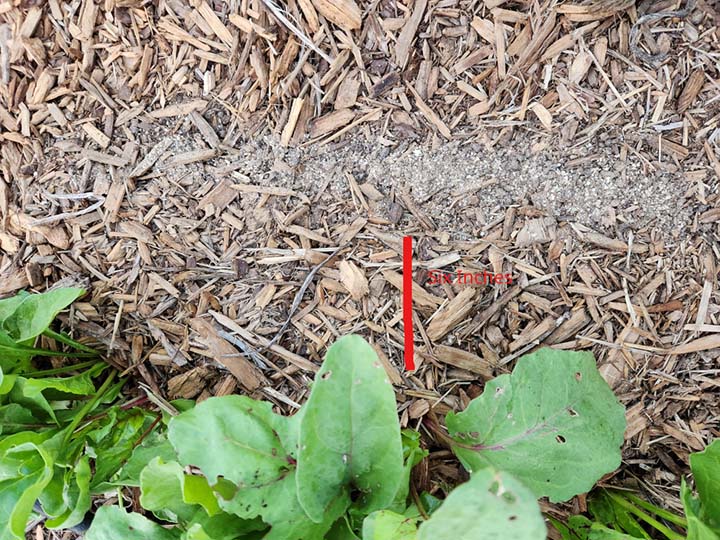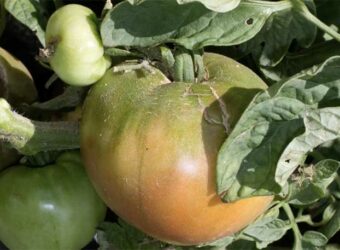Picking a fertilizer for your plants can be confusing. Different fertilizers work best in different situations. This guide will tell you when a 5-10-10 fertilizer is appropriate.
What Is 5-10-10 Fertilizer?
5-10-10 fertilizer has five percent nitrogen, ten percent phosphorous, and ten percent potassium. The numbers on the front of the fertilizer bag are explained in more detail in this article.
Nitrogen is used throughout the plant, and without it, plants become stunted and can die. They also have few blossoms. Phosphorous is involved in the transformation of sunlight into the starches, oils, and proteins plants need. It also triggers blooms and fruit set. Potassium is involved in the circulation of nutrients in the plant. It also helps fruits grow and mature.
Why Use 5-10-10?
I use 5-10-10 when I want the plant to bloom and set fruit instead of putting on lots of foliage. 5-10-10 is especially good in the vegetable garden with tomatoes, melons, pumpkins, and squash. Flowering trees like magnolias benefit from the phosphorous and potassium. Acidic versions of 5-10-10 help flowers like azaleas and hydrangeas to thrive. Finally, 5-10-10 is used on fruit, nut, and citrus trees when they start to bloom and grow fruit.
Types of 5-10-10 Fertilizer
Fertilizer comes in several forms. Here are explanations of each form.
Liquid Fertilizer
Liquid fertilizers can be concentrates that need mixing with water or ready-to-use. I prefer concentrates because although they are more expensive initially, they make more fertilizer for less total cost.
Liquids are used in place of water and are immediately taken up by the plant. Liquid fertilizers typically have to be reapplied every seven to fourteen days. I did not find a liquid 5-10-10 fertilizer.
Water-Soluble Fertilizer
Water-soluble 5-10-10 is a granular fertilizer or powder that dissolves in water. It is then applied in place of water by drenching the ground around the plant. These fertilizers typically have to be applied every seven to fourteen days, just like liquid fertilizers. I did not find a water-soluble 5-10-10 fertilizer.
Fertilizer for Hydroponics
Hydroponics uses a liquid nutrient solution instead of soil to grow plants. Either liquid or water-soluble fertilizer can be used for a hydroponic system.
Granular Fertilizer
Granular fertilizer is made of little granules that look like small rocks. It can be water-soluble or used by spreading the granules near the target plant. All the 5-10-10 fertilizers I found are granular.
Organic Fertilizer
Organic fertilizers only have ingredients found in nature. In addition, organic fertilizers have been submitted to a certifying agency, such as the USDA, to prove they only use things allowed in organic gardening. I did not find an organic 5-10-10.
Slow-release Fertilizer
Slow-release fertilizer releases its nutrients slowly because it is coated with a substance that gradually breaks down. As the substance breaks down, the nutrients are released to the plants. Slow-release fertilizers typically take seven days to start showing results but do not have to be reapplied for several weeks or even a few months.
When and How Do I Apply 5-10-10 Fertilizer?
The exact way you use a particular 5-10-10 fertilizer is listed on the label. However, here are some common ways to use 5-10-10.
Houseplants
I think 5-10-10 fertilizer is best used for plants primarily grown for their flowers or fruit. The extra phosphorous and potassium keep the plant’s energy focused on flowering and fruit set, not growing foliage. Mix one teaspoon of fertilizer with one gallon of water and use it in place of watering once every two weeks.
Annual Flowers
I use one tablespoon of fertilizer per gallon of water for annual flowers and drench the soil around the plants. 5-10-10 fertilizer is best used when the flowers start to bloom to keep them from producing foliage instead of blooms. For granular 5-10-10 fertilizer, spread one cup per ten feet of row or hundred square feet of bed, then water the area.
Existing Ornamental Plants
Use the same as with annual flowers.
Bulbs and Tubers
When foliage is grown, and buds are visible, spread one cup of fertilizer per hundred square feet or ten feet of row. This will cause the blooms to be vibrant and colorful.
Vegetable Gardens

I think 5-10-10 fertilizer is ideal for plants like cucumbers, melons, pumpkins, squash, and tomatoes once the vines are mature. This fertilizer encourages lots of blooms, fruit sets, and delicious vegetables.
I side-dress my vegetables with one cup per ten feet of row. I use a fertilizer with more nitrogen for my non-vine vegetables.
You can read my article to know in more detail about how to fertilize vegetable gardens, as well as my favorite fertilizers for vegetable gardens.
Trees
Flowering trees like magnolias benefit from spreading 5-10-10 fertilizer under the canopy. I use one cup per hundred square feet. Fruit and citrus trees benefit from the same amount of fertilizer. For potted fruit and citrus trees, mix one teaspoon of water-soluble fertilizer in one gallon of water and use it in place of watering every two weeks once blooms start. Stop fertilizing the trees in the fall so they will go dormant.
Lawns
5-10-10 is not a good fertilizer for lawns. They need more nitrogen than 5-10-10 contains.
Where Do I Buy 5-10-10 Fertilizer?
You can get 5-10-10 fertilizer at online dealers like Amazon and garden supply stores. Walmart carries it, but Lowe’s and Home Depot do not appear to do so.
My Recommendations for 5-10-10 Fertilizer
5-10-10 fertilizer is surprisingly difficult to find. I have located two manufacturers of 5-10-10 fertilizer. Both provide minimal information on the fertilizer online, and I could not find them in the stores near me. Here are the two fertilizers.
1. Master Nursery 5-10-10 Tomato & Vegetable Food

Master Nursery 5-10-10 Tomato & Vegetable Food is available from Walmart and Amazon. The active ingredients are ammonic nitrogen, organic nitrogen, calcium, iron, zinc, and manganese. Calcium helps prevent blossom end rot in tomatoes. Iron, zinc, and manganese are essential to plants, as well. Master nursery guarantees your satisfaction or your money back.
2. Lilly Miller Morcrop Tomato & Vegetable Food 5-10-10

Lilly Miller Morcrop Tomato & Vegetable Food 5-10-10 is fortified with essential minerals. In addition, it is made in the United States of America. This granular formulation is good for vining vegetables that don’t need much nitrogen once they bloom. It won’t cause the vines to grow a lot of foliage at the expense of the blooms.
What Are the Ingredients in 5-10-10 Fertilizer?
All fertilizers have five percent nitrogen, ten percent phosphorous, and ten percent potassium. Most manufacturers add proprietary ingredients they believe will help plants grow better and use the nutrients in the fertilizer better. Some fertilizers have more of the twelve elements every plant needs to grow. The rest of the fertilizer is fillers to help the fertilizer spread easier and ingredients to keep the fertilizer from spoiling.
Frequently Asked Questions
Why does 5-10-10 fertilizers work well on beans?
Beans are able to use nitrogen in the air. The air contains much more nitrogen than soil, so beans don’t need much supplemental nitrogen. 5-10-10 is good because it has a little extra nitrogen, but not so much that the beans just grow foliage and never have beans. The phosphorous triggers blooms and the potassium helps them grow and mature.
Is 5-10-10 fertilizer good for peonies?
5-10-10 fertilizer works well for flowering plants like peonies once they start flowering. I would use a fertilizer like 10-10-10 when they first start growing, then switch to the 5-10-10 when the blooms start forming.
Why does 5-10-10 fertilizer look like rocks?
Granular fertilizer looks like rocks because of the elements in it.
Why use 5-10-10 fertilizer instead of 33-0-0 on cucumbers?
You should use 5-10-10 after the vines finish growing and when the vine is ready to blossom and set fruit. 33-0-0 is good when the plants start making runners but continuing to use it after that will promote vine growth at the expense of blossoms and cucumbers.
How long does it take 5-10-10 to work?
The granular formulation takes about seven days to start working. The liquid starts working immediately.
How long does 5-10-10 fertilizer last?
The liquid formulation works for seven to fourteen days. The granular formulation works for about four weeks.
Is 5-10-10 good fertilizer for fall?
No, it is more appropriate when plants are flowering and having fruit. Once the flowers and fruit are done, 5-10-10 is not the best fertilizer.
In conclusion, 5-10-10 helps trigger plants to bloom and grow fruits and vegetables without supplying so much nitrogen that the plant just puts on foliage instead of blooming. 5-10-10 fertilizer is hard to find, however, and I only located two brands. Neither brand provides much information online, and I could not locate it in stores near me. 3-4-4 fertilizer is a readily available substitute.







Can I use 5 10 10 on fall garlic
You can use 5-10-10 on fall garlic.